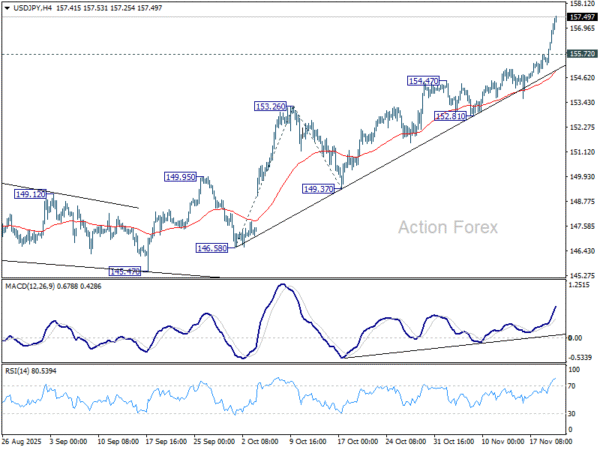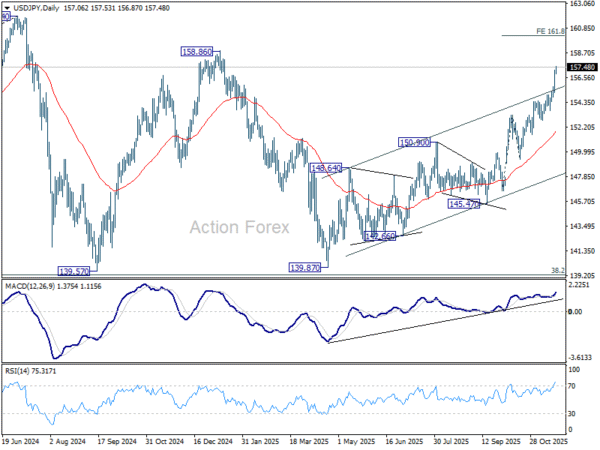Risk-On Returns, Fed Cut Bets Fade Further, NFP Looms – Action Forex
Investor sentiment turned decisively positive in Asian markets today, even as traders continued dialing back expectations for a December Fed rate cut following the hawkish tone in FOMC minutes released overnight. The shift in rate expectations would normally pressure risk assets, but momentum instead swung in the other direction thanks to a powerful catalyst out of the U.S. tech sector.
Chip stocks in Japan and South Korea were the clear standouts, surging after Nvidia’s earnings crushed Wall Street forecasts. The company also issued a stronger-than-expected sales outlook for Q4, providing a fresh jolt of optimism for the AI complex. The rally in semiconductors fed through regional benchmarks, with U.S. futures trading sharply higher ahead of the September jobs report.
Whether the rebound can sustain into the U.S. session remains the big question. If Nvidia-driven enthusiasm holds, investors may once again push AI valuation anxiety into the background—at least temporarily—helping stabilize broader risk sentiment after a shaky week.
All eyes now turn to September non-farm payrolls. The report is expected to show 53k increase in payrolls, a modest improvement from August’s weak 22k print, while unemployment is projected to hold steady at 4.3%. Still, the data come with an important caveat: they are dated.
The Bureau of Labor Statistics confirmed it will not publish a full October jobs report due to the now-resolved federal shutdown, and will instead combine October and November payrolls into a single release on December 16—six days after the Fed’s final policy meeting of the year. That means policymakers will go into December lacking two months of labor-market detail.
Against that backdrop, today’s NFP figures may not sway the Fed in any meaningful way. With the minutes revealing resistance to cutting again in December, only an extreme surprise is likely to disrupt the current bias toward a hold. The market has largely absorbed that message, so reaction to the print could be subdued.
In Japan, Yen’s slide remains relentless. Even comments from a BoJ hawk failed to spark support, as the currency was overwhelmed by the strong rally in domestic equities. As USD/JPY vaulted through the 157 handle, officials attempted verbal intervention once again.
Chief Cabinet Secretary Minoru Kihara warned that the Yen is experiencing sudden, one-way movements and that authorities are watching for “excessive fluctuations or disorderly moves. But the warnings—repeated frequently over the past week—had no discernible market impact.
For the week so far, Dollar is leading the performance table, followed by Loonie and then Aussie. Yen is the weakest, trailed by Swiss Franc and Kiwi. Euro and Sterling are drifting in the middle of the pack.
In Asia, at the time of writing, Nikkei is up 2.91%. Hong Kong HSI is up 0.23%. China Shanghai SSE is up 0.33%. Singapore Strait Times is up 0.21%. Japan 10-year JGB yield is up 0.039 at 1.811. Overnight, DOW rose 0.10%. S&P 500 rose 0.38%. NASDAQ rose 0.59%. 10-year yield rose 0.010 to 4.133.
Fed minutes highlight resistance to December cut
The October FOMC minutes revealed a deep policy split, and “strongly differing views”, showing officials wrestling with how quickly to bring rates toward neutral. While the majority continues to expect additional easing “over time,” many expressed reluctance to cut again in December, marking a more hawkish tone than markets had priced in. Traders reacted swiftly, pushing the probability of a December rate cut down to roughly 33%, compared with near 50% earlier in the week.
Participants were divided across a wide spectrum of views. Several argued that economic conditions would justify another quarter-point reduction at the next meeting “if the economy evolved about as they expected over the coming intermeeting period.”
However, “many participants” judged that keeping rates “unchanged for the rest of the year” would be more “appropriate” under their baseline outlooks. Others supported further easing but emphasized that December may not necessarily be the right moment.
The Committee delivered its second straight cut in October, moving rates to 3.75–4.00%, but Chair Jerome Powell emphasized at the press conference that another move in December was “not a foregone conclusion.” The internal debate documented in the minutes supports that caution and signals stronger resistance to front-loading additional cuts.
BoJ hawkish voice emerges as Koeda presses for further tightening
BoJ board member Junko Koeda delivered one of the clearest hawkish signals from the Bank in recent months, arguing that real interest rates remain “significantly low” and must be moved back toward “a state of equilibrium” to avoid “unintended distortions” later.
With Japan’s output gap hovering around zero and labor market tightness intensifying amid widespread staff shortages, she said in a speech that current economic backdrop justifies continued normalization. In her view, the BoJ should “continue to raise” the policy rate as economic conditions improve, adjusting monetary support in line with the broader recovery in activity and prices.
Koeda stressed that underlying inflation is running near 2%, but achieving the target sustainably requires the Bank to test how firmly “underlying inflation has remained stable or been anchored”. That means looking beyond headline data to evaluate whether price momentum can hold as temporary factors fade.
Her message contrasted with recent political pressure urging caution on tightening, reinforcing the divide between policymakers seeking gradual normalization and government voices favoring prolonged accommodation.
PBoC stays on hold, but markets still see easing ahead
China kept its benchmark lending rates unchanged for the sixth straight month today, leaving the one-year Loan Prime Rate at 3.0% and the five-year rate at 3.5%. The decision was widely expected, as policymakers continue to balance the need to support the economy with the desire to avoid fuelling financial instability.
Despite the steady stance, markets remain convinced that monetary easing has merely been delayed, not abandoned. Expectations are building for a “dual cut” — both policy rates and banks’ reserve requirement ratio — in the first quarter of 2026.
A run of softer October activity data has strengthened that view. Exports contracted, retail sales slowed further, and the property-related drag has shown little sign of easing. Combined, these have heightened concerns that Q4 will bring more headwinds rather than signs of stabilization.
Adding to the pressure, new bank lending fell sharply in October as both households and businesses remained reluctant to take on fresh debt amid weak confidence and ongoing US-China trade tensions. Without a meaningful pickup in credit demand, Beijing may soon have little choice but to act more decisively to shore up activity in early 2026.
USD/JPY Daily Outlook
Daily Pivots: (S1) 155.85; (P) 156.52; (R1) 157.82; More…
USD/JPY accelerates higher today and intraday bias stays on the upside for 158.85 key structural resistance, and then 161.8% projection of 146.58 to 153.26 from 149.37 at 160.17. On the downside, below 155.72 minor support will turn intraday bias neutral and bring consolidations, before staging another rise.
In the bigger picture, current development suggests that corrective pattern from 161.94 (2024 high) has completed with three waves at 139.87. Larger up trend from 102.58 (2021 low) could be ready to resume through 161.94 high. Decisive break of 158.85 structural resistance will solidify this bullish case and target 161.94 for confirmation. On the downside, break of 150.90 restiveness turned support will dampen this bullish view and extend the corrective pattern with another falling leg.


